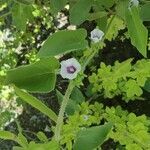Herbs annual, twining or prostrate, with ± retrorsely or spreading hispid axial parts. Stems 1-2 m. Petiole 1.5-6.5 cm; leaf blade lanceolate-ovate or oblong-ovate, 3-9 X 1.5-3.5 cm, base cordate, margin entire, apex long attenuate, sometimes acute, appressed hispid; lateral veins 6 or 7 pairs. Cymes axillary, sessile or nearly so, usually 1-3-flowered; bracts linear-lanceolate, 3-8 mm, abaxially pilose. Pedicel very short or absent. Sepals ovate, ± equal, 7-9 mm, abaxially densely hirsute, apex linear-acuminate; inner sepals slightly narrower. Corolla pink or purplish, rarely white, campanulate, 7-9 mm, midpetaline bands densely hirsute outside; limb triangular-lobed. Stamens included. Ovary hirsute, 2-loculed, 4-ovuled. Stigma capitate, 2-lobed. Capsule ± globose, 5-6 mm in diam., spreading hirsute, apiculate. Seeds gray-brown, 2.5-4 mm, glabrous, minutely reticulate. 2n = 30.
Annual; stems twining, pubescent or hispid, covered with both long and short hairs.. Leaf-blade ovate-cordate to linear-oblong, 2.5–8 cm. long, 0.8–4 cm. wide, usually subhastate at the base with rounded lobes, pilose to glabrescent; petiole 1–4.5 cm. long.. Inflorescences 3–many-flowered, very rarely only 1-flowered, axillary, subsessile or peduncle up to 1 cm. long; bracts linear; pedicels about 5 mm. long.. Sepals ovate, acuminate at the apex, hispid-pilose, spreading in young fruit; basal part 5 mm. long, 3–4 mm. wide; apical part 4 mm. long, 0.5 mm. wide.. Corolla mauve, white, pink or white with a mauve centre, 6–9 mm. long, 13 mm. across (up to 1.55 cm. long when flattened out).. Capsule 5–6 mm. in diameter, pubescent (Fig. 22/5, p. 102).. Seeds black, finely punctate, glabrous, 2.5 mm. long (Fig. 24/4, p. 131.)
Variable annual herb. Stems twining or prostrate, pilose, 1-2 m long. Leaves cordate-lanceolate to cordate-oblong, 20-90 x 5-55 mm, thinly strigose to subglabrous, apex acuminate, nerves densely pilose; margin entire, somewhat ciliate; petiole pilose, 10-80 mm long. Inflorescence axillary, subsessile or peduncle up to 15 mm, 3-many-flowered. Flowers usually subsessile; bracteoles pilose, 3-8 mm. Sepals subequal, ovate-lanceolate with linear-acuminate, spreading tips, 7-8 mm long, pilose. Corolla tubular to funnel-shaped, white, pink or mauve, or white with mauve centre, 7-9 mm long; midpetaline areas pilose. Capsule subglo-bose, apiculate, hairy, 5-8 mm in diameter. Seeds glabrous, minutely punctate, 2.5-3.5 mm long, black.
A perennial shrub. It has slender trailing stems. These re-grow each year from a woody rootstock. The young growth has rigid hairs which bend backwards. The leaves are narrow and sword shaped. They are 4-10 cm long by 1-2 cm wide. They are bright green on top and hairy underneath. The flowers are about 2 cm across. They are white or pale pink with a darker centre. They occur singly in the axils of leaves. The fruit is a capsule about 1 cm across which is round and hairy. The seeds are smooth.
Twining or prostrate annual herb. Leaves entire, ovate-cordate to linear-oblong, subhastate at base with rounded lobes. Inflorescence (1)3-many-flowered, subsessile or Peduncle up to 15 mm long. Sepals ovate, acuminate, hispid-pilose. Corolla up to 10 mm long. Capsule hairy. Seeds finely punctate, glabrous. Flowers mauve, white, pink or white with mauve centre.
Inflorescences axillary, (1) 3-many flowered, subsessile or peduncle up to 1·5 cm. long; bracts linear or lanceolate, pilose; peduncle up to 1·5 cm. long; bracts linear or lanceolate, pilose; pedicels more or less 5 mm. long, pilose.
Leaf lamina ovate-cordate to linear-oblong, 2–10 × 0·8–7 cm., usually subhastate at the base with rounded lobes, apex long-attenuate to acuminate, obtuse or acute, margin entire pilose-strigose or glabrescent; petiole 1–6 cm. long.
Sepals subequal, ovate, acuminate, up to 9 mm. long, hispid-pilose, spreading in young fruit; basal part 5 × 4 mm.; apical part 4 × 0·5 mm.
Corolla tubular to funnel-shaped, mauve, white, pink or white with a mauve centre, up to 10 mm. long, midpetaline areas pilose.
Stems twining or prostrate, pubescent or hispid, covered with both long and short hairs.
Capsule ovoid-globose to globose, hairy, apiculate by the style-base.
Seeds black, finely punctate, glabrous.
White flowers about 1/2 in. long.
Ovary with long hairs.
Very variable annual.
Sparingly pubescent
A slender twiner

